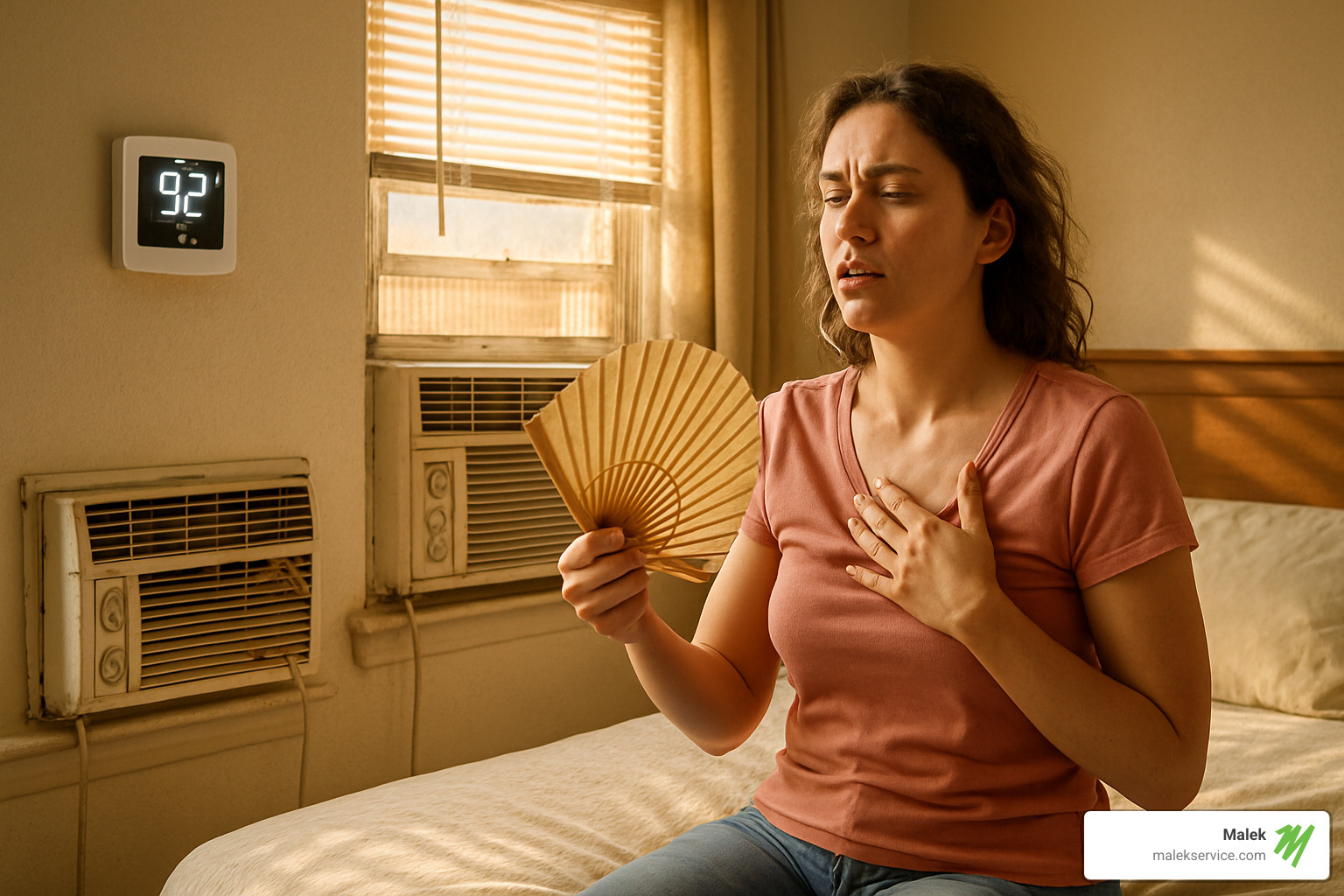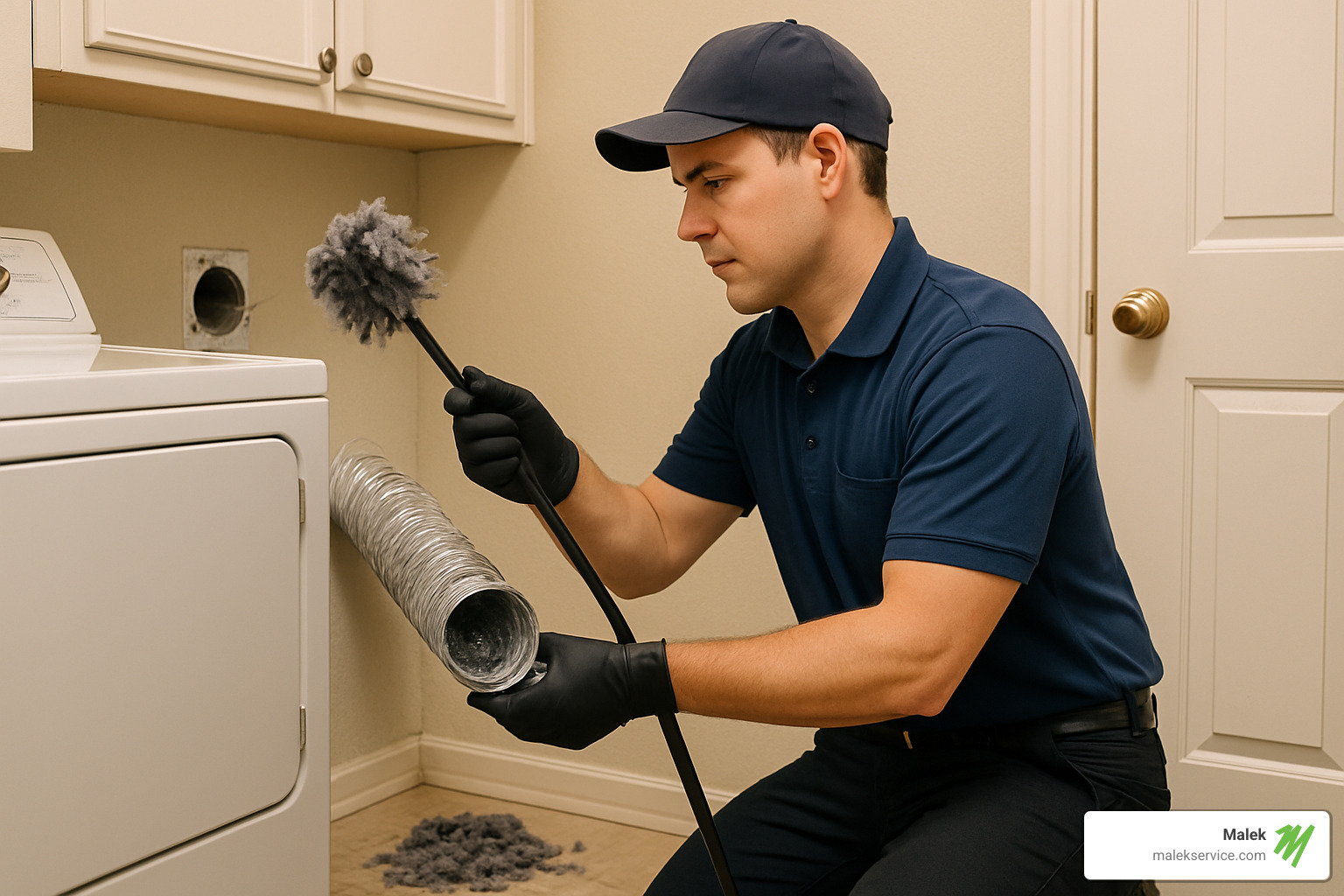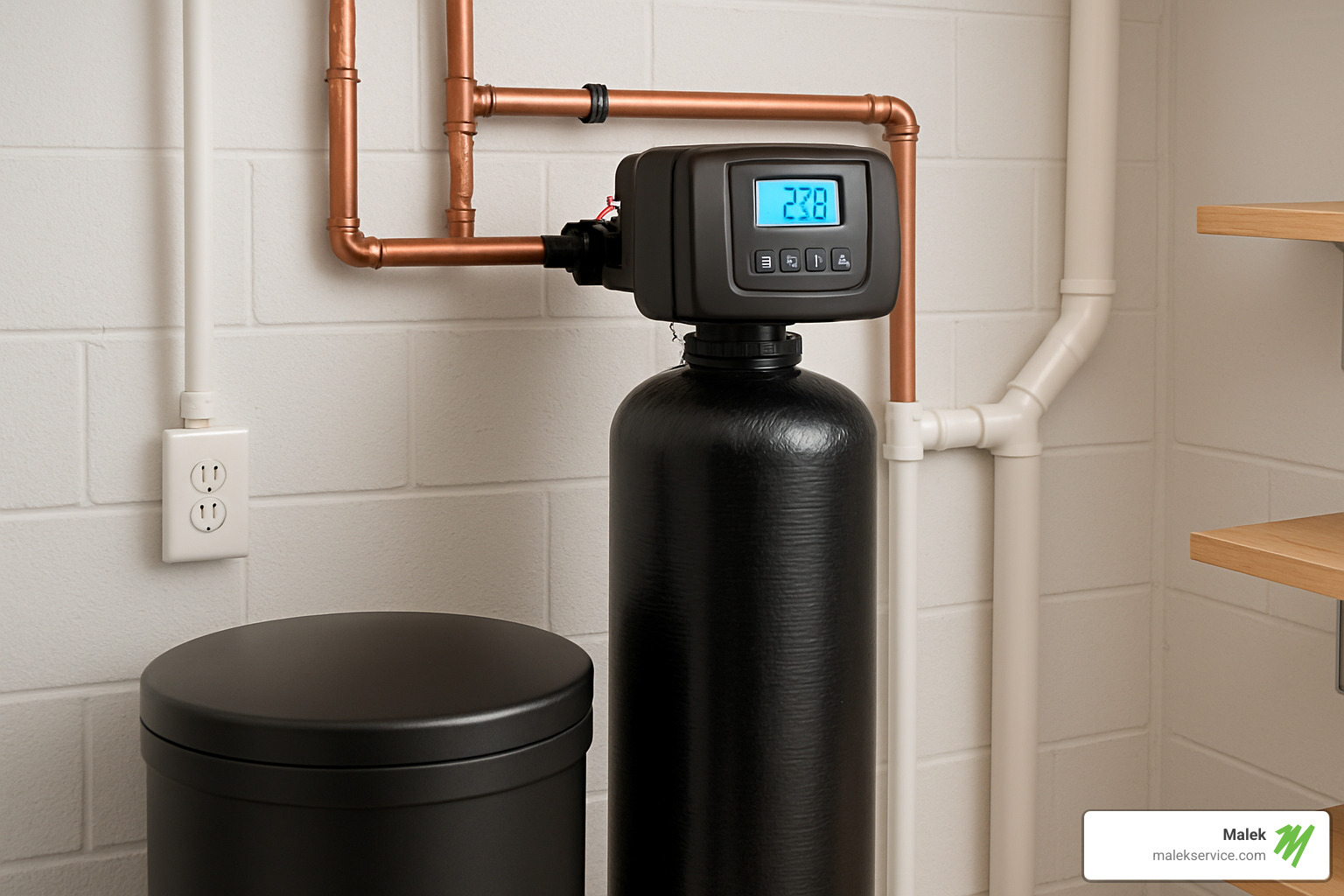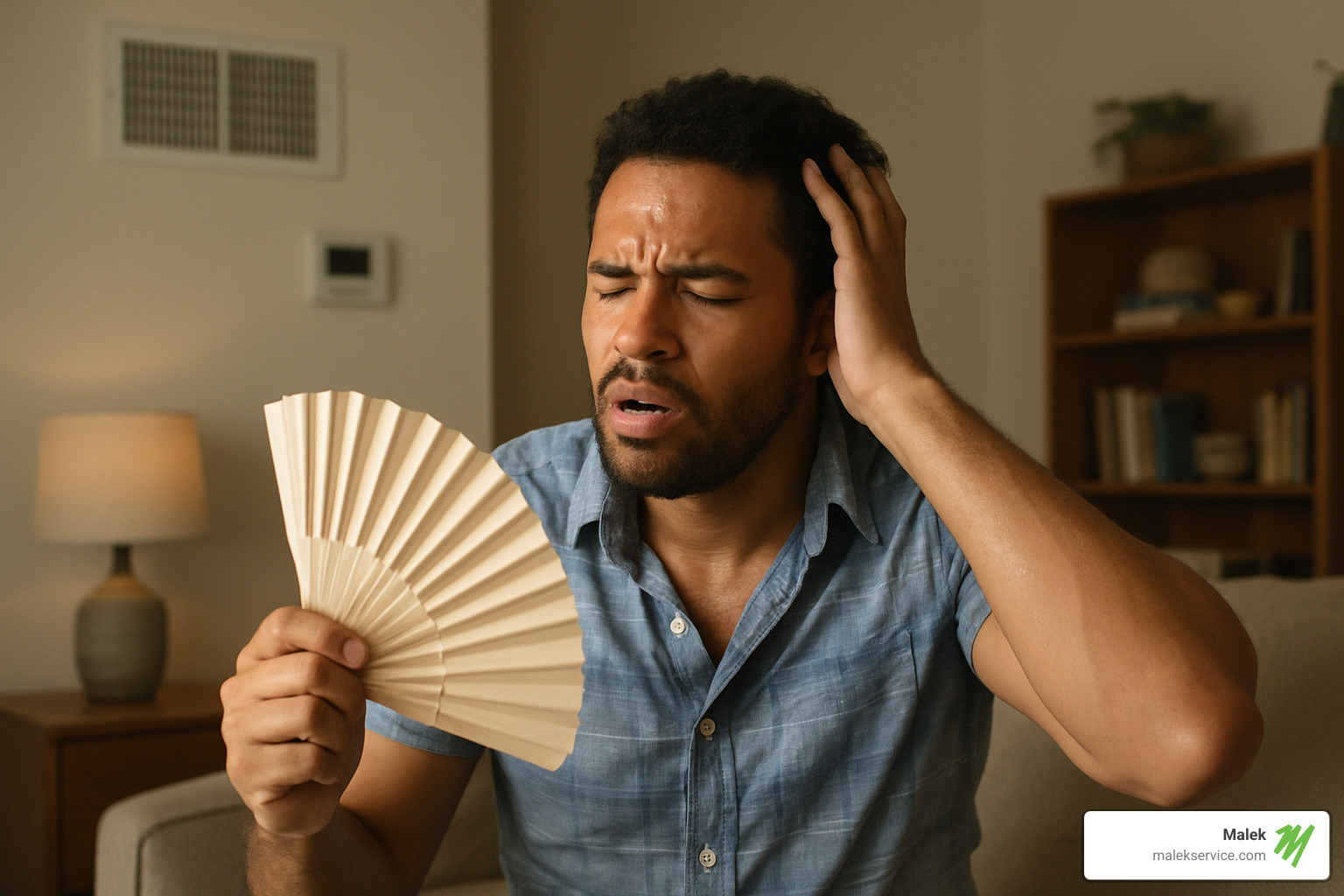Why Your Room Won’t Cool Down
Why is my room not cooling down despite running the AC for hours? This frustrating problem has several common causes:
| Common Causes | Quick Solutions |
|---|---|
| Dirty air filter | Replace filter every 1-3 months |
| Blocked or closed vents | Remove obstructions and ensure all vents are open |
| Leaky ductwork | Have ducts inspected and sealed professionally |
| Poor insulation | Check windows, doors, and attic insulation |
| Oversized/undersized AC | Consult professional for proper sizing |
| Thermostat issues | Verify settings and proper placement |
| Direct sunlight exposure | Use blinds, curtains, or window films |
| Heat-generating electronics | Reduce usage or improve ventilation |
When your room feels like an oven despite your air conditioner working overtime, the problem could stem from simple maintenance issues or more complex system failures.
According to ENERGY STAR, a typical home loses 20-30% of conditioned air through duct leaks alone. This significant loss directly impacts your comfort and explains why some rooms remain stubbornly warm while others cool properly.
Most cooling problems fall into two categories: obstacles preventing cool air from reaching your room, or excessive heat entering faster than your AC can remove it.
I’m Courtney Zalesak, Vice President at Malek Service Company, where I’ve spent over a decade helping homeowners solve cooling problems just like yours. Throughout my years addressing why is my room not cooling down situations, I’ve identified the most effective solutions that balance quick fixes with lasting results.

Why Is My Room Not Cooling Down? Quick 60-Second Diagnosis
When your home feels like a sauna despite your AC running full blast, a little detective work can save you time and frustration. Before reaching for the phone, try this quick 60-second checkup to figure out why your room is not cooling down.
Start with your thermostat – it sounds obvious, but even smart homeowners occasionally forget to check if it’s actually set to “COOL” mode. Is the temperature set lower than what’s currently in the room? And is your fan set to “AUTO” rather than constantly “ON”? These simple settings make a big difference.
Next, take a peek at your air filter. I can’t tell you how many times I’ve visited homes where the filter looked more like a dust bunny farm than a filtering device! A clogged filter is like trying to breathe through a thick blanket – your AC system struggles just as much.
Walk around your room and examine all vents. Are they wide open? Is that new bookshelf or sofa blocking airflow? Place your hand in front of each vent – you should feel a strong, cool breeze, not a wimpy trickle of air.
One quick test professionals use: measure the temperature difference between the air entering your return vent and the air coming out of your supply vents. You should feel a 15-20°F difference. If not, your system isn’t cooling properly.
I remember helping a frustrated family in College Station who couldn’t figure out why their room wasn’t cooling down for days. Turns out their teenager had accidentally closed all the bedroom vents while rearranging furniture. Once opened, the room cooled within an hour!
Dirty Air Filter: Top Reason Why Your Room Is Not Cooling Down
If there were a “Most Wanted” list for cooling problems, dirty filters would be public enemy number one. This simple maintenance item causes more cooling headaches than almost anything else.
When your filter gets clogged with dust, pet hair, and other debris, it creates a bottleneck in your entire system. Imagine trying to sip a thick milkshake through a coffee stirrer – that’s essentially what your AC is attempting to do with a dirty filter.
The restricted airflow creates a domino effect: less air reaches your rooms, your evaporator coil might freeze up (further reducing cooling), and your system works overtime without delivering comfort. All while your energy bills climb higher!
Here at Malek, our service records show dirty filters account for about 30% of summer cooling complaints across Houston, College Station and surrounding areas. The solution is refreshingly simple – regular filter changes:
Replace filters more frequently during summer months when your system works hardest. Most Texas homes need changes every 1-2 months during peak cooling season, and every 3 months otherwise. Got pets, allergies, or construction nearby? Change them even more often.
For more ways to keep your system running smoothly, check out our detailed AC Maintenance guide.
Thermostat Settings: Still Wondering “Why Is My Room Not Cooling Down at 72°F?”
You’ve set your thermostat to a comfortable 72°F, but your room feels more like 82°F. What gives? Sometimes the issue isn’t your AC system but how it’s being controlled.
Double-check the obvious first – is your thermostat definitely set to “COOL” mode? I’ve seen plenty of red-faced homeowners realize they accidentally hit the “HEAT” button. The fan setting matters too – “AUTO” typically works better than “ON” for cooling, as “ON” continuously circulates air, even when it’s not being cooled.
Thermostat location is crucial but often overlooked. Think of your thermostat as the temperature referee for your home. If it’s installed in a naturally cool hallway, near a drafty door, or in direct sunlight, it’s getting inaccurate readings. Your system might think your home is perfectly comfortable while your bedroom remains stuffy.
One memorable customer in College Station called us in desperation: “My living room is 80 degrees even though my thermostat says 72!” The culprit? Their thermostat was installed in a shaded, well-ventilated hallway, while their sun-drenched living room with west-facing windows was practically baking.
Smart thermostats with remote sensors can be game-changers for homes with temperature inconsistencies, allowing you to average readings from multiple rooms or prioritize specific areas during different times of day.
Circuit Breakers & Power Glitches
Sometimes the mystery of why your room is not cooling down has a surprisingly simple electrical explanation. Your AC might not be receiving the power it needs to function properly.
Start by checking your circuit breakers. Most AC systems have two separate breakers – one for the indoor air handler and another for the outdoor condenser unit. If either has tripped (look for a switch that’s not fully in the “ON” position), your cooling will be compromised. Reset any tripped breakers and see if that solves the problem.
Don’t forget to check the outdoor disconnect box – that grey electrical box mounted on the wall near your outdoor unit. Landscapers, children, or even a strong storm can accidentally flip this safety switch to the “OFF” position.
If your outdoor unit is making a strange humming sound but not starting up, or if it runs briefly before shutting down, you might have a failing capacitor. These components are like the battery that helps start your compressor and fan motors.
One of our senior technicians shared this common scenario: “Last summer, I visited five different homes in one week where the outdoor disconnect switch had been accidentally flipped by lawn services. The homeowners were sweating it out indoors, completely unaware of such a simple fix!”
Electrical issues beyond simple breaker resets should always be handled by professionals. Your AC system uses high voltage electricity that can be dangerous without proper training and equipment.
Hidden Airflow & Envelope Roadblocks Inside the House
Even with a perfectly functioning AC system, physical barriers in your home can prevent cooled air from reaching certain rooms or allow excessive heat to enter. These hidden obstacles often explain why your room is not cooling down despite everything else working correctly.
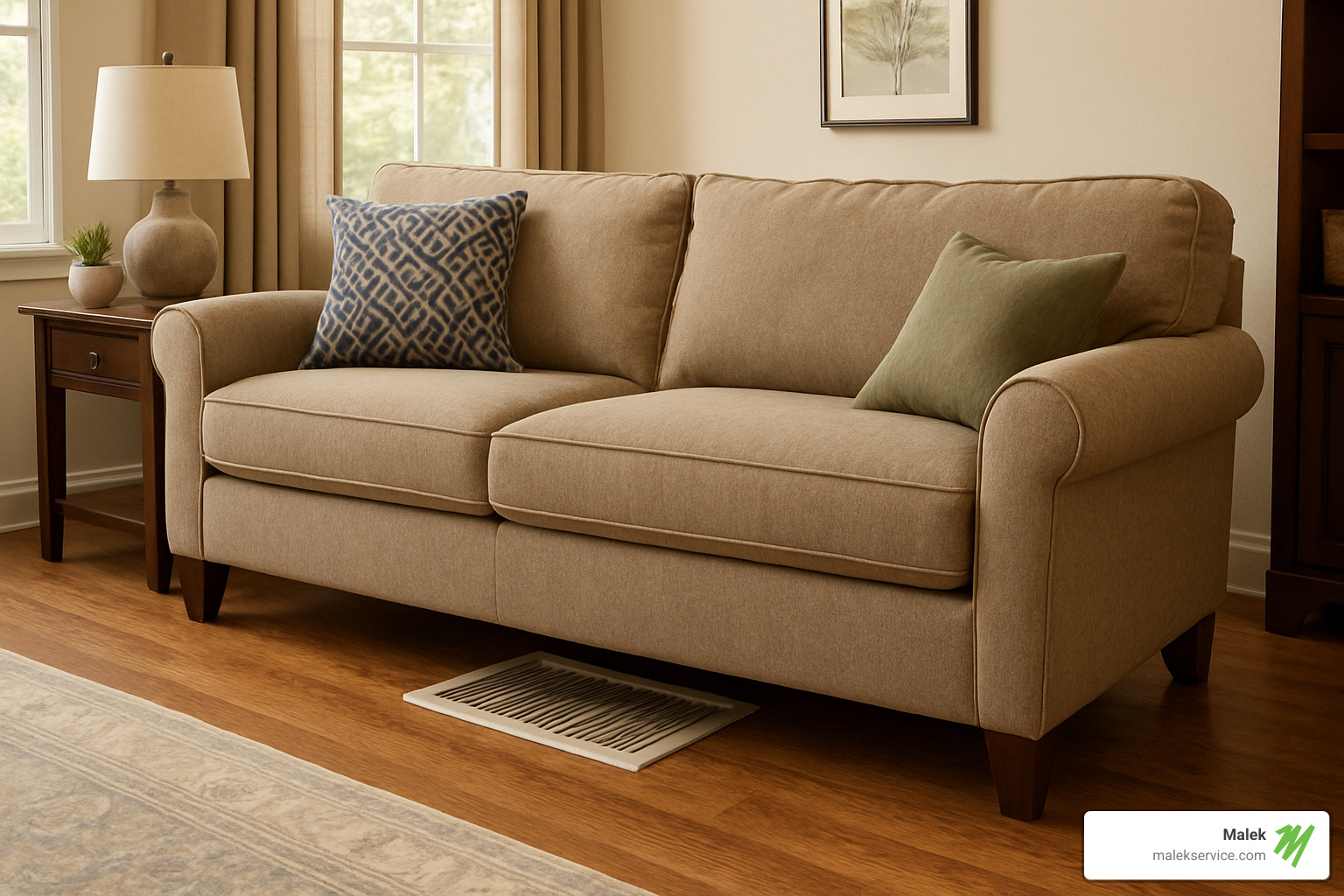
Furniture & Rugs Smothering Supply Vents
That beautiful sectional sofa might be the secret villain in your cooling saga. I can’t tell you how many times I’ve visited homes where why is my room not cooling down mysteries were solved by simply moving furniture!
Your stylish sofa, bookcase, or bed might be blocking critical airflow without you realizing it. When furniture sits directly over floor vents, cool air gets trapped underneath instead of circulating throughout your room. Similarly, wall vents blocked by headboards or entertainment centers can’t properly distribute the cool air you’re paying for.
Even thick area rugs can be culprits, acting like insulators over floor vents and preventing cool air from entering your living space.
The fix is wonderfully simple: give your vents some breathing room. Try to maintain at least 18 inches of clearance around all vents. For those tight spaces where furniture simply must stay put, vent extenders can redirect airflow out from under furniture, while vent boosters (small fans) can help push air through partially obstructed pathways.
I remember one family in Huntsville who called us convinced their AC was failing. When I arrived, I found their new sectional was blocking not one but two major vents! After a quick furniture shuffle, their living room transformed from a sauna to a comfortable oasis within hours.
Second-Floor & West-Facing Rooms Getting Full Sun
If you’ve ever wondered why is my room not cooling down despite the rest of your home feeling comfortable, location might be your answer. Unfortunately, physics works against certain rooms in your home.
Hot air naturally rises (what we call the stack effect), making upstairs rooms harder to cool even with a perfectly functioning system. Add to this the intense solar radiation through windows, especially west-facing ones in the late afternoon, and you’ve got a recipe for a hot, uncomfortable space.
A customer in Brenham once told me her home office was consistently 8 degrees hotter than the rest of her house. After investigating, we realized the western exposure was essentially turning her office into a greenhouse every afternoon!
Thankfully, several solutions can help combat these natural challenges. Blackout curtains, cellular shades, or reflective blinds dramatically reduce heat gain through windows. Window films that block UV rays while still allowing light are perfect for rooms where you don’t want to lose the view or natural light.
Outside the home, strategic landscaping makes a difference too. Shade trees planted on the west side of your home provide natural cooling, while awnings or exterior shutters block direct sunlight before it can heat up your glass.
Don’t underestimate the power of ceiling fans, either. While they don’t lower the actual temperature, they create a wind-chill effect that can make a room feel 4-6 degrees cooler.
Leaky Interior Doors and Poor Return Paths
Your air conditioning system works on a simple principle: it needs to both supply cool air to rooms and return warm air to be cooled again. When interior doors are closed without adequate return air paths, this cycle breaks down.
Have you noticed doors that mysteriously slam shut or are difficult to open? Hear whistling sounds around door frames? These are classic signs of pressure imbalance caused by poor air return paths, and they often explain why is my room not cooling down effectively.
Our senior technician often tells customers that simply keeping bedroom doors open during the day can improve cooling efficiency by 20-30%. Of course, privacy sometimes requires closed doors, which is where proper return air solutions become essential.
Door undercuts (ensuring at least 3/4-inch clearance above the floor) allow air to flow under closed doors. For rooms that need more airflow, transfer grilles installed in walls or doors create pathways for air movement between spaces. In more complex situations, jumper ducts can connect isolated rooms to hallways via flexible ducts, providing much-needed return air paths.
One family in College Station was baffled by their master bedroom staying hot while the guest room stayed comfortable. The solution? Their master bedroom door fit too tightly to the floor, creating a virtual air lock when closed. A simple door trim created the needed return path, and their comfort issues disappeared overnight.
Ductwork, Insulation & Equipment Size: The Big System Culprits
When simple fixes don’t solve your cooling troubles, it’s time to look deeper into your home’s infrastructure and HVAC system design. These bigger issues often explain why your room is not cooling down despite your best efforts.
20-30% Air Lost in Leaky Ducts—Seal It or Lose It
Here’s a shocking fact: ENERGY STAR duct-sealing research shows that typical homes lose 20–30% of conditioned air through leaky ductwork. That’s right—up to a third of the cool air you’re paying for might never reach your rooms! According to ENERGY STAR, these losses significantly impact both comfort and energy bills.
You might have leaky ducts if you notice stubbornly warm rooms, surprisingly high energy bills, excessive dust throughout your home, or that general feeling that some rooms just never feel right. One Bryan homeowner told us, “I thought my AC was failing until your tech found holes in my attic ductwork. That cool air was basically air-conditioning my attic for years!”
Fixing duct leaks offers several options. For accessible ducts, you might try DIY sealing with mastic sealant (not regular duct tape, which fails quickly). For comprehensive results, our professionals can reach difficult areas and apply proper sealing techniques. For the most stubborn situations, we recommend Aeroseal technology—an innovative solution that seals leaks from inside the ductwork, reaching places human hands simply can’t access.
“After Malek sealed our ductwork, we found we’d been losing almost 25% of our cooled air to the attic,” shared one relieved Franklin resident. “The difference is night and day in our master bedroom!”
Want to know exactly where your cool air is escaping? Consider scheduling one of our HVAC Inspections to pinpoint and address those sneaky leakage issues.
Insulation Gaps & Single-Pane Windows Let Heat Pour In
Sometimes the answer to why is my room not cooling down isn’t about getting more cool air in—it’s about keeping heat out. Think of insulation as your home’s shield against the Texas heat.
For our climate, the Department of Energy recommends attic insulation of at least R-30, but many homes (especially older ones) fall woefully short. One Navasota customer was shocked when we showed him his attic had R-11 insulation—barely a third of what’s needed in our region!
Heat sneaks in through numerous pathways: insufficient attic insulation allows heat to radiate downward; settled or missing wall insulation creates hot spots; single-pane windows transfer outdoor heat directly inside; and tiny gaps around doors, pipes, and outlets invite hot air to crash your cool party.
Windows are particularly problematic. According to Department of Energy data on window efficiency, windows account for 10–25% of your heating and cooling expenses. That west-facing room with old windows? It’s fighting a losing battle against the afternoon sun.
“The temperature in our bonus room dropped by 8 degrees after adding proper attic insulation,” reported a College Station homeowner. “We didn’t change anything about our AC system—we just stopped heat from pouring in from above. We should have done this years ago!”
Wrong-Sized AC: Too Small Struggles, Too Big Short-Cycles
Your air conditioner might be working perfectly—and still failing to cool your home properly if it’s the wrong size for your space.
An undersized system is like trying to cool your entire house with a window unit. It runs constantly without ever catching up, especially during peak summer heat. This endless operation wears equipment out prematurely and still leaves you uncomfortable. As our senior technician puts it, “It’s like using a garden hose to put out a wildland fire—technically you’re applying water, but you’ll never keep up with the spreading flames.”
Surprisingly, an oversized system creates different but equally frustrating problems. These units cool too quickly and shut off before properly dehumidifying your air. The result? A clammy feeling despite the cool temperature, uncomfortable temperature swings as the system rapidly cycles on and off, and premature equipment failure from this constant starting and stopping. Plus, all that cycling wastes energy.
Proper sizing isn’t guesswork—it requires a professional Manual J load calculation that considers your home’s square footage, ceiling heights, window specifications, insulation values, local climate, occupant count, and even heat-generating appliances. One number doesn’t fit all.
“At least half the systems we evaluate were improperly sized,” observes our lead comfort consultant. “Many installers simply use square footage and ignore dozens of other crucial factors.”
If your system is 10–15 years old and struggling, investing in a properly sized replacement might solve your cooling woes while actually reducing your long-term costs. Rather than continuing to repair an aging, inefficient system that’s wrong for your home, a right-sized unit provides the comfort you deserve with the efficiency you need.
Fix It Fast: DIY Tweaks vs Professional Solutions
When addressing why your room is not cooling down, it helps to understand which fixes you can handle yourself and which require professional expertise.
| DIY Solutions | Professional Solutions |
|---|---|
| Replace air filters | Refrigerant leak repair |
| Clear vent obstructions | Ductwork design and sealing |
| Adjust thermostat settings | System sizing and replacement |
| Install window treatments | Electrical component repair |
| Rearrange furniture | Zoning system installation |
| Use ceiling fans | Air balancing |
| Seal window/door gaps | Compressor/condenser repair |

Simple DIY Wins to Try Today
Before reaching for the phone, roll up your sleeves and try these quick fixes that often solve cooling woes in minutes.
Swap that filter! It’s amazing how many cooling problems disappear with this 5-minute task. A clean filter is like giving your AC system a breath of fresh air – literally. Your system will thank you with better airflow and cooling power.
Open ALL vents throughout your home. I know it seems logical to close vents in unused rooms, but this actually creates pressure problems and makes your system work harder. Your AC was designed to cool your entire home evenly.
Those blinds and curtains aren’t just for privacy – they’re your first defense against the Texas sun. Keep them closed during peak heat, especially on western exposures. One College Station customer told me this simple change dropped her afternoon temperatures by 4 degrees!
Ceiling fans are cooling superheroes when used correctly. Make sure yours spin counterclockwise in summer to push cool air downward. The breeze creates a wind-chill effect that makes you feel cooler without changing the thermostat.
Heat-generating activities can sabotage your cooling efforts. Try grilling outside instead of using the oven, and save laundry and dishwashing for evening hours when it’s naturally cooler.
A Caldwell homeowner recently shared: “I was skeptical that these simple fixes would help, but after spending one afternoon replacing the filter, moving my bookcase away from the vent, and hanging blackout curtains, my son’s room went from a stuffy 78°F to a comfortable 72°F! I wish I’d done this months ago.”
When to Call the Pros for Lasting Comfort
While DIY fixes work wonders for many cooling issues, certain problems require professional expertise – both for safety and effectiveness.
Refrigerant problems should always be handled by certified technicians. If your system is low on refrigerant, it means there’s a leak somewhere that needs proper repair. This isn’t just about comfort; refrigerant handling requires EPA certification for environmental and safety reasons.
Electrical issues can be dangerous and complex. If you suspect problems with capacitors, contactors, or wiring, it’s time to call in the experts. Our technicians have the training and equipment to safely diagnose and fix these issues.
Persistent cooling problems that don’t respond to DIY efforts likely indicate deeper system issues. When you’ve tried everything and that room still feels like a sauna, professional diagnosis will save you time and frustration.
A frozen evaporator coil needs immediate professional attention. This icy buildup signals airflow restrictions or refrigerant problems that can damage your system if ignored.
If your AC is turning on and off frequently (short-cycling), it’s crying out for help. This stresses components and wastes energy while failing to properly cool and dehumidify your home.
Unusual noises or odors are your system’s way of saying “something’s wrong!” Whether it’s grinding, squealing, or that mysterious burning smell, these are signals that shouldn’t be ignored.
For these more complex issues, our experienced technicians at Malek Service provide fast, reliable solutions. Check out Our HVAC Services for comprehensive cooling solutions.
Advanced Upgrades: Zoning & Air Balancing for Multi-Level Homes
Some homes – especially larger or multi-level ones – have structural challenges that simple fixes can’t overcome. That’s when advanced solutions like zoning and air balancing make sense.
Zoning systems are like having multiple mini-systems in one home. Instead of a one-temperature-fits-all approach, zoning divides your home into separate comfort areas, each with its own thermostat. This means your upstairs bedrooms can finally be as comfortable as your downstairs living room.
A Houston family recently told me, “After years of freezing downstairs while sweating upstairs, our new zoning system lets us set different temperatures for each floor. The kids have their perfect temperature upstairs, while we stay comfortable downstairs. It’s changed how we live in our home.”
Beyond comfort, zoning reduces energy waste by cooling only the areas you’re using. Why cool empty bedrooms during the day or the kitchen while you’re sleeping?
Air balancing is another professional service that fine-tunes your existing system. Our technicians measure airflow at every register, then make precise adjustments to dampers and ductwork to ensure every room gets its fair share of conditioned air.

For homes with challenging layouts or persistent hot spots, these advanced solutions typically pay for themselves through improved comfort and energy savings. Many customers tell us they wish they’d made these upgrades years earlier after experiencing the dramatic improvement in whole-home comfort.
If you’re tired of room-to-room temperature rollercoasters, consider scheduling an AC Tune-Up where we can evaluate whether these advanced solutions might be right for your home.
Frequently Asked Questions About Why My Room Is Not Cooling Down
Does closing vents in unused rooms help cool the rest faster?
No, closing vents in unused rooms actually reduces cooling efficiency. This common misconception often makes cooling problems worse, not better.
Your air conditioning system is designed to deliver a specific amount of airflow throughout your entire home. When you close vents, you’re essentially putting a kink in your system’s operation. It’s like trying to breathe through a straw while pinching it halfway down – everything has to work harder for less result.
Closing vents creates increased pressure in your duct system, forcing your blower to work harder than it was designed to. This extra strain can lead to your evaporator coil freezing up (a repair that’s definitely not DIY-friendly) and creates pressure imbalances that make your whole house less comfortable.
“I spent years closing the vents in my guest bedroom thinking I was being efficient,” admits a Bryan homeowner. “After a technician explained how it was actually making my system work harder, I opened them all up and noticed my whole house cooled more evenly – and my electric bill went down!”
Instead of closing vents, keep them all open and consider a proper zoning system if you need different temperatures in different areas of your home.
How can I tell if my ducts are leaking or just dirty?
When you’re wondering why is my room not cooling down, duct issues are often the hidden culprit. But how can you tell if they need cleaning or sealing?
If your ducts are leaking, you’ll likely notice rooms that are consistently difficult to cool no matter what you do. Your energy bills will typically be higher than normal, as you’re essentially cooling your attic or crawlspace instead of your living room. Sometimes you can spot visible disconnections in accessible ductwork, and many homeowners report excessive dust returning shortly after cleaning their home.
Dirty ducts, on the other hand, will often announce themselves with visible dust or debris blowing from your vents when the AC kicks on. You might notice musty or stale odors circulating when your system runs, increased allergy symptoms among family members, or stubborn dust buildup around your vent covers.
Here’s a simple test you can do yourself: Wait until evening, then shine a flashlight into your supply registers while someone else looks at the ductwork in the attic (if accessible). If you see significant dust buildup or, worse, actual daylight coming through from attic spaces, your ducts likely need professional attention for cleaning or sealing.
The most accurate assessment comes from professional duct testing, which can precisely measure leakage and determine whether you need cleaning, sealing, or both.
Will upgrading to double-pane windows really cool my hottest room?
Yes, window upgrades can significantly improve cooling in hot rooms, especially those that face the harsh afternoon sun. It’s not just marketing hype – the Department of Energy confirms that energy-efficient windows can reduce your cooling costs by 15-30%.
You’ll notice the biggest improvement when upgrading from old single-pane windows, particularly in rooms with large windows facing south or west. If you can feel radiant heat when standing near your windows or the glass feels hot to the touch during sunny days, window upgrades will make a dramatic difference.
“I was skeptical about spending money on new windows,” shares a Navasota homeowner, “but after replacing the windows in our west-facing family room, the temperature dropped by 8 degrees during afternoon hours without changing anything else. I can actually sit on my couch without sweating now!”
While full window replacement represents a significant investment, there are more affordable alternatives that can help while you save up for new windows:
Installing window films that block UV and infrared light offers immediate relief without changing the windows themselves. Adding cellular or honeycomb shades creates insulating air pockets that significantly reduce heat transfer. Even simply using reflective window coverings during peak sun hours can make a noticeable difference.
For scientific research on how windows affect home energy use, check out the Department of Energy’s window efficiency guide for detailed information.
Conclusion
Let’s face it – there’s nothing more frustrating than a stubborn room that refuses to cool down, especially during those scorching Texas summers. If you’ve been wondering why is my room not cooling down, you’re not alone. The good news? Most cooling challenges fall into the categories we’ve explored: airflow obstacles, heat sneaking in, system hiccups, or air distribution problems.
Throughout my years at Malek Service, I’ve visited hundreds of homes across College Station, Houston, and nearby communities where families were dealing with exactly this issue. What I’ve learned is that cooling solutions often require both simple homeowner actions and targeted professional expertise.
Start with those DIY fixes we discussed – they really do make a difference! Replace that dirty filter (it’s amazing how many cooling problems this solves), clear any blocked vents, double-check your thermostat settings, and be mindful of heat-generating activities during the hottest parts of the day. Sometimes these simple tweaks are all it takes to transform a stuffy space into a cool retreat.
If you’ve tried these approaches and your room still feels more like a sauna than a sanctuary, it might be time for professional help. Our technicians are trained to look beyond the obvious, using their experience to uncover those tricky underlying issues that DIY methods can’t address.
Regular maintenance remains your best defense against cooling problems. Much like changing your car’s oil prevents engine issues, an AC Tune-Up catches potential cooling problems before they leave you sweating through those triple-digit Texas afternoons.
For those persistent cooling mysteries or more complex situations – like multi-level homes with dramatic temperature differences or older systems struggling to keep up – our Air Conditioning Repair & Installation team brings the technical know-how and personalized approach needed to restore comfort to every corner of your home.
Don’t let one hot room diminish your quality of life or disrupt your sleep. With the right approach and expertise, balanced, efficient cooling isn’t just possible – it’s absolutely achievable throughout your entire home, regardless of its age, size, or design challenges.
After all, your home should be your comfortable haven, not a collection of climate zones ranging from “just right” to “unbearably hot.” Let’s solve that cooling puzzle together!
